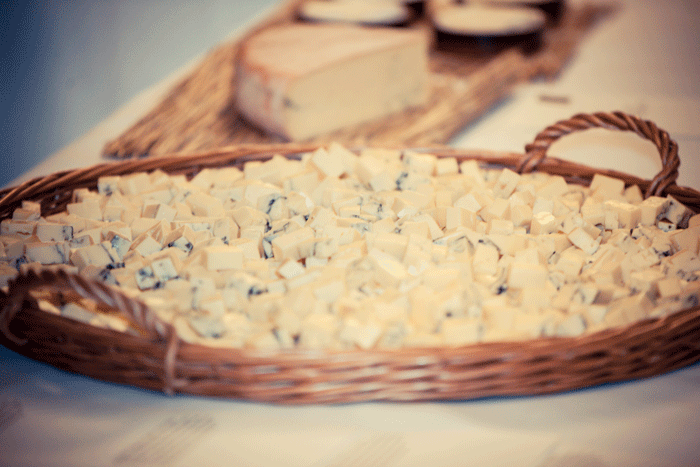Sake and cheese… the ultimate pairing?
Author: Guest Blogger
I’ll start by clarifying, if I may, that in Japanese ‘Sake’ doesn’t have quite the same meaning as it does here: instead it refers to any kind of alcoholic beverage. What we in the West think of as Sake is actually Nihon-shu, 日本酒 – the first two characters mean “Japan”; the last one means “alcoholic beverage” (easy to remember as it looks like a bottle with magic drops trying to escape!). While it’s useful to know how to impress your friends on the next visit to an Izakaya 居酒屋 (Japanese Bar), here, I’ll stick with Western convention, and use the word Sake.
Sake is very in vogue; New York, the early adopter for so many drinks trends, has been in the grip of Sake-fever for some time. Now, new independent breweries are presenting their most exclusive products to our European markets, and at Berry Bros. & Rudd we have selected the ones that we consider to be the best representatives of their categories. Sakes are classified by their rice polishing ratios – these range from the Junmai, which has at least 70 percent of the rice kernel left to produce a rich, deep flavour profile, to the Daiginjo which – in some cases – has only 30 percent of the rice kernel remaining to give clean, aromatic styles of Sake.
The variety of rice is also important: Yamadanishiki, Omachi and 500 Mangoku, are the most popular, and are found in the majority of Sakes. The latter is used in the Tamagawa “Tokubetsu Junmai” made by Philip Harper (an English teacher from Cornwall who moved to Japan 26 years ago to became the only non-Japanese Toji, Master Brewer, in Japan). He is now one of the most distinguished producers in Japan, achieving higher natural strength by experimenting with different yeast strains.
The yeast strains play a very important role in the production of Sake – for instance, “No. 9” yeast is particularly popular for Daiginjo, and produces smooth and fine fruity aromas reminiscent of ripe apples and hints of melon. Another important factor that distinguishes Sake from other alcoholic drinks is the use of the Kōji (a variety of mould), which is the key to breaking down starches into sugar and allowing the alcoholic fermentation to take place.
As with wine, when it comes to matching Sake with food, there is no right or wrong answer. As Sake is generally rich in Umami flavours it goes fantastically well with the majority of Washoku 和食(Japanese cuisine) as well as all sorts of cheeses, specially the amino-acid (glutamate) rich ones such as Emmental, Parmesan and the Spanish Cabrales to mention just a few.
At our upcoming Sake & Cheese Matching event with Paxton & Whitfield, we will be showing how versatile Sake can be while exploring the interaction of flavours. Sake expert Asami Tasaka, UK Sales Director of World Sake, will be on hand to guide us.
One theory as to why Sake goes so well with cheese is that the foods eaten in the areas where Sake is produced, mainly in Japan’s mountainous hinterlands, tend to be strongly flavoured and salty – much like our favourite cheeses. There’s a science bit too: Sake is rich in amino acids, and drinking it with cheese intensifies the overall Umami experience to a point that feels like “1+1=6”. In my view, Sake and cheese were made for each other. Kampai!! (Cheers!!)
To taste for yourself, join us at our Sake & Cheese Matching event this July.




Hi dear,
I always enjoy reading your e-mail magazine. I live in Yokohama Japan. Today’s topic is matching Japanese sake and food. That’s sounds interesting.
You wrote ‘500 Mangoku’ as a rice’s name in the issue.
As you know, it’s a pronoun: Gohyakumangoku in Japanese. ‘Gohyaku’ means 500 as you write. However, if you read ‘five-hundred Mangoku’, it sounds strange.
Please put some notes if you want.
Best regards,
Tsuyoshi
Dear Deguchi-san
Thank you very much for your reply.
You are very right pointing out the correct Japanese grammatical spelling of Gohyakumangoku.
Nevertheless, the name 500 Mangoku is also widely used by Japanese Breweries and its distributors nowadays.
Also, as this is a very popular rice variety for Sake making and taking into account that much of our readers might not be fluent Japanese speakers, I think that the name 500 Mangoku is much easier to remember!
Regarding the Sake and Cheese event that took place on our Pickering Cellar last Friday, I think it was a great success and everyone enjoyed an entertaining and informative evening thanks to our two special hosts Asami Tasaka from World Sake and Jeremy Bowen from Paxton & Whitfield.
With best regards,
Alejandro R. Noda Vila